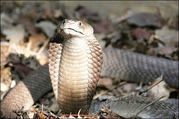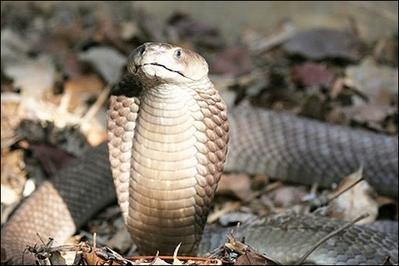
December 7, 2007

Richard Leakey has given an excellent quotation for reflection when thinking about the foundation pursuits of cryptozoology. With regard to this new discovery, Leakey has said: “There have to be many other unreported species.”
True, indeed.
A new giant species of spitting cobra — about 2.6 metres (8.5 feet) long and with enough venom to kill up to 20 people in one bite — has been discovered in Kenya, a study said Friday.
The large brown spitting cobra, initially included under the black-necked spitting cobra species, was discovered at a snake farm in June 2004, but confirmed as a separate species this year.
The black-necked species grows to a maximum two metres (6.5 feet), with an average of 1.5 metres (4.9 feet), scientists said, making the new species the largest in the world.
The new Naja Ashei species, named after James Ashe who founded the Bio-Ken snake farm in Watamu on the Kenyan coast, produces 6.2 millilitres of liquid venom, which is the among the largest amounts of venom ever extracted from a snake at a single milking.
It confirms Ashe’s fears that the Naja Ashei was a different kind of snake that was classified under the wrong species, yet it was qualified to form its own species.
Herpetologist Wolfgang Wuster and Donald G. Bradley in a study said the new species was found in the dry lowlands of northern and eastern Kenya, northeastern Uganda, southern Ethiopia and southern Somalia.
“But the most common area you can find this species is along the Kenyan coast,” said herpetologist Royjan Taylor, who manages the Bio-Ken snake farm.

The discovery brings to six the number of African spitting cobra species, the study said.
Although cobras have the highest public profile among venomous snakes, “our understanding of the taxonomy of the group has until recently remained woefully inadequate, particularly in terms of understanding the species limits within different well-differentiated groups,” the experts said.
But after observing morphological variations between the brown and black cobras, the pair concluded that the “differences are indeed a result of the population being different evolutionary lineages.”
The discovery appears to resolve the status of the eastern and northeastern Africa species, which was the remaining puzzle in the systematics of the African spitting cobras, which were lumped into a single species in the 20th century, the experts said.
Effectively, the massive, combative and venomous Naja Ashei takes its position among the dozens of known cobra species, including the King Cobra, the longest snake in natutal habitat known to produce prodigious amounts of neurotoxin.
Experts have witnessed the new species successfully swallowing a rabbit, a two-and-half long foot monitor lizard and five-foot-long puff adder.
Taylor explained that although the new species is not listed as endangered, conservation efforts must be increased since the reptile is threatened by human activities and encroachment.
“Although I am a naturalist and conservationist who is passionate about all wildlife, my heart goes out to the reptiles that are often misunderstood — especially snakes,” he added.
Because of this discovery, he said, he would help develop anti-venom for Naja Ashei bites.
“More research work needs to be done on their venom and its implication to snakebite treatment and anti-venom manufacture,” said Taylor, whose contribution led to the new discovery.
World-renowned conservationist Richard Leakey said the discovery of the giant species was “exciting.”
“There have to be many other unreported species but hundreds are being lost as their habitats disappear under the continued mismanagement of our planet,” said Leakey. ~ by Bogonko Bosire“World’s largest spitting cobra species found in Kenya: study,” AFP, December 7, 2007.
About Loren Coleman
Loren Coleman is one of the world’s leading cryptozoologists, some say “the” leading living cryptozoologist. Certainly, he is acknowledged as the current living American researcher and writer who has most popularized cryptozoology in the late 20th and early 21st centuries.
Starting his fieldwork and investigations in 1960, after traveling and trekking extensively in pursuit of cryptozoological mysteries, Coleman began writing to share his experiences in 1969. An honorary member of Ivan T. Sanderson’s Society for the Investigation of the Unexplained in the 1970s, Coleman has been bestowed with similar honorary memberships of the North Idaho College Cryptozoology Club in 1983, and in subsequent years, that of the British Columbia Scientific Cryptozoology Club, CryptoSafari International, and other international organizations. He was also a Life Member and Benefactor of the International Society of Cryptozoology (now-defunct).
Loren Coleman’s daily blog, as a member of the Cryptomundo Team, served as an ongoing avenue of communication for the ever-growing body of cryptozoo news from 2005 through 2013. He returned as an infrequent contributor beginning Halloween week of 2015.
Coleman is the founder in 2003, and current director of the International Cryptozoology Museum in Portland, Maine.
Filed under Breaking News, Cryptotourism, CryptoZoo News, Cryptozoologists, Cryptozoology, New Species